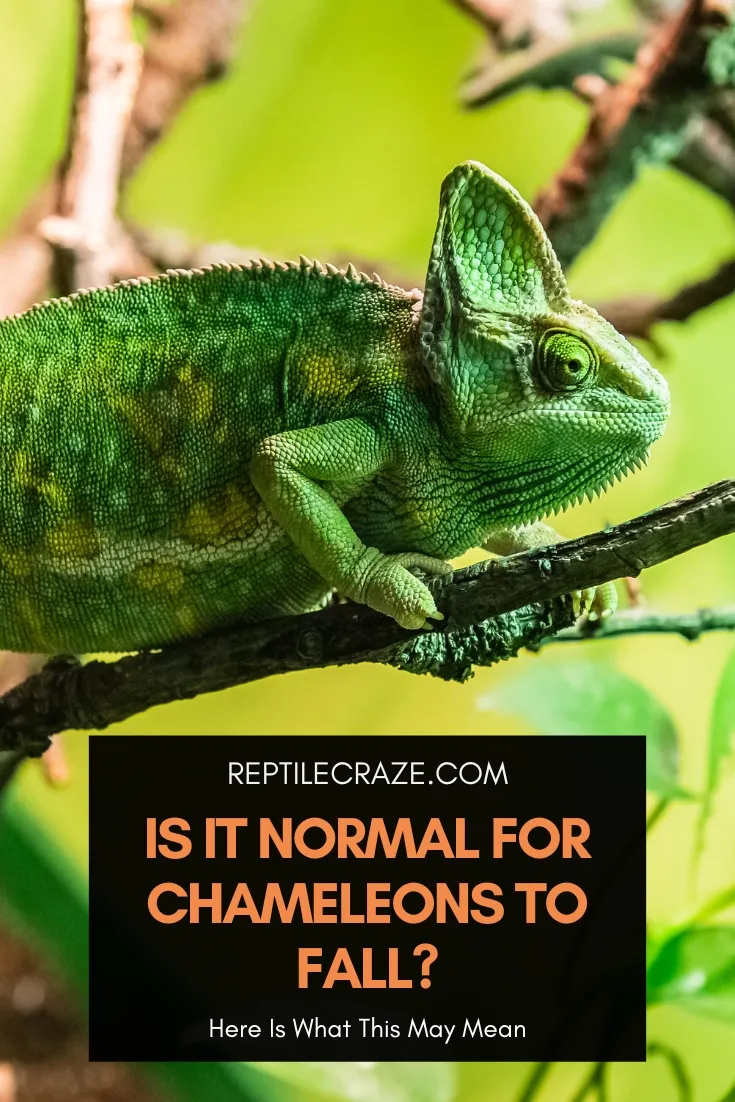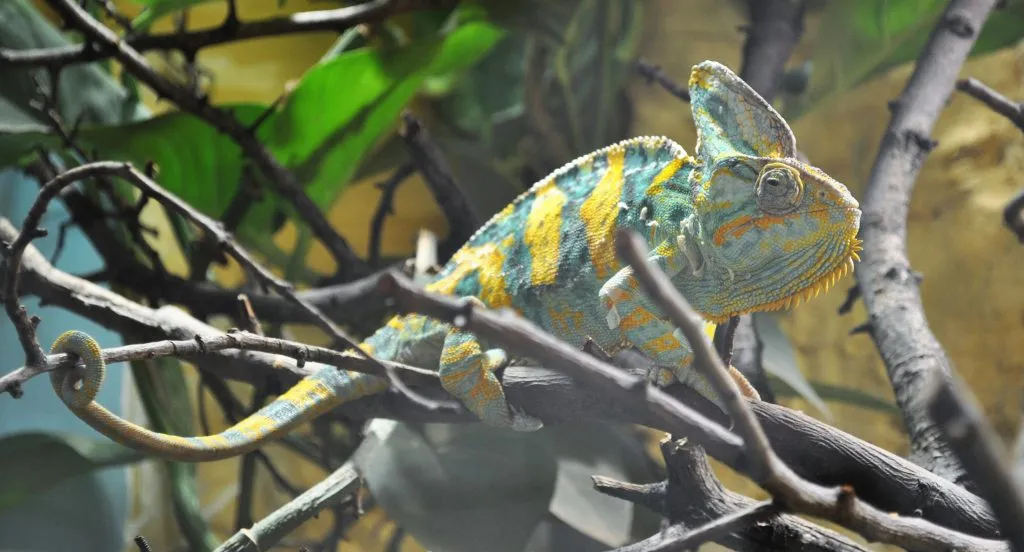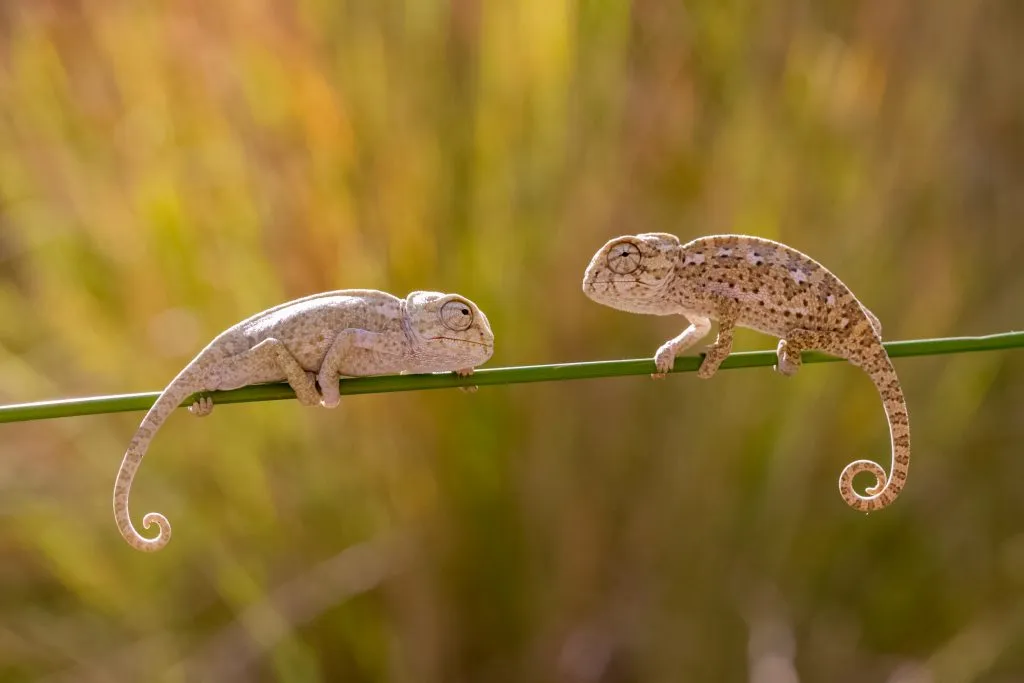
You’re watching your pet chameleon climbing around in its vivarium, when suddenly your chameleon falls off the branch. You gasp and wonder, did it hurt itself? Is there something wrong?
When a chameleon falls, they might not move for twenty or thirty minutes. This temporary paralysis is normal, so don’t panic if your chameleon doesn’t move right away. If no limbs are broken, the chameleon will start crawling again.
Read on to learn more about why a chameleon falls, whether it is normal, and what to do if you see your chameleon fall off its branch.
My chameleon fell – what do I do?
A chameleon falling off a branch is no immediate cause for alarm. However, you should check your chameleon for injuries, as it may have broken a limb (including its tail!) or damaged internal organs.
After the fall, monitor your chameleon to see if it seems well or if it keeps falling. A healthy chameleon can experience an occasional fall, but frequent falls may be a sign your chameleon is sick.
If you notice anything wrong with your chameleon, contact a vet ASAP.
Is it normal for a chameleon to fall?
A chameleon can fall once in a while, usually by accident. Chameleons evolved to be expert climbers, due to their “two-toes” hands and feet and prehensile tail.
They’re more likely to fall if climbing on unfamiliar or slippery surfaces, such as furniture, which is not part of their natural habitat.
A chameleon can fall in its vivarium if climbing a wet branch or if a branch breaks beneath its weight. A chameleon can also fall on purpose if it gets scared.
What happens if a chameleon falls on its head?
If a chameleon lands on its head, the impact of the fall might cause its brain to jiggle around in their skull, causing brain damage or other damage to internal organs.
If after a fall your chameleon stops moving around or is resting for long periods during the day (which is very rare for chameleons), make an appointment with a vet to check for internal damage.
A chameleon is less likely to be injured if it falls from a short distance onto a relatively soft, spongy surface, like bedding or grass.
A harder surface, like tiles or cement, will cause injury, especially if the chameleon falls from a high place.
Why does my chameleon keep falling?

If your chameleon keeps falling, it might be because it has a nutritional deficiency or has metabolic bone disease. This disease is common among reptiles, and chameleons, especially veiled chameleons, are particularly vulnerable.
Check for the following symptoms if your chameleon keeps falling:
- lack of coordination
- lethargy
- curved or swollen limbs
- paralysis
- curved spine
- droopy lips
- soft jaw
A combination of these symptoms may mean your chameleon has metabolic bone disease. Make an appointment with the vet and adjust your chameleon’s diet as soon as possible.
What causes MBD?
MBD is often caused by a lack of calcium, phosphorous and vitamin D, as well as inadequate exposure to UVB light.
As captive reptiles rely on humans for their nutrition and environmental needs, they are much more likely to develop MBD than reptiles in the wild.
How to prevent MBD
You can treat and prevent MBD by ensuring your chameleon has a varied diet and sufficient nutrients, especially calcium and vitamin D. The following foods for chameleons are especially high in calcium:
- black soldier fly larvae
- crickets
- snails
If you’ve already been feeding your chameleon a varied diet, you’ll need to include calcium supplements in your feedings to ensure adequate nutrition.
Adding a dusting of calcium powder to your chameleon’s meals is the easiest way to add more calcium to its diet.
Also ensure that your chameleon is getting adequate UVB light. It needs at least 12 hours of UVB light a day. The right amount of nutrition plus the right amount of light help make a healthy chameleon.
Other illnesses that may cause chameleon falls
You chameleon might not have MBD, but could be suffering from another type of illness if it keeps falling. The most likely diseases could be osteoporosis or kidney disease.
In any case, check with a vet if your chameleon seems lethargic, doesn’t eat, and falls frequently.
My chameleon is healthy – why does it keep falling?
If your chameleon is healthy but keeps falling, your vivarium might not be tall enough.
In the wild, chameleons climb tall trees high above the ground, allowing them plenty of room to get a good grip on branches.
Your chameleon might not have enough room in a short vivarium and lose its grip and fall while it is trying to get higher, even though it is not possible.

It may even climb upside down on the screen cover and fall from the top of the cage.
Chameleon vivariums should be at least two feet (60cm) tall. Ensure your vivarium is tall enough for your chameleon to climb around. This is an excellent enclosure for most chameleons.
The branches may not be sturdy enough, either.
Chameleons may have good grip, but they need branches that can hold their weight in order to stay above ground. Even wild chameleons fall if a branch can’t hold their weight.
Further, you need to make sure that the branches have a rough surface. Bamboo, for example, is harder to grip for chameleons.
We recommend getting these branches here and combining them with live plants so that your chameleon can climb without any problems.
A healthy chameleon can occasionally fall, but frequent falls signal that something is wrong with your chameleon or its environment.
Whatever the cause for the fall, always check for injuries and contact a vet if your chameleon seems ill or injured. Healthy chameleons are happy chameleons!
- Enchi Ball Python: A Unique and Stunning Morph of Python regius - March 27, 2025
- Emerald Tree Monitor: The Enigmatic Green Guardian of the Rainforest - March 26, 2025
- The Egyptian Cobra (Naja haje): A Fascinating Serpent - March 25, 2025
